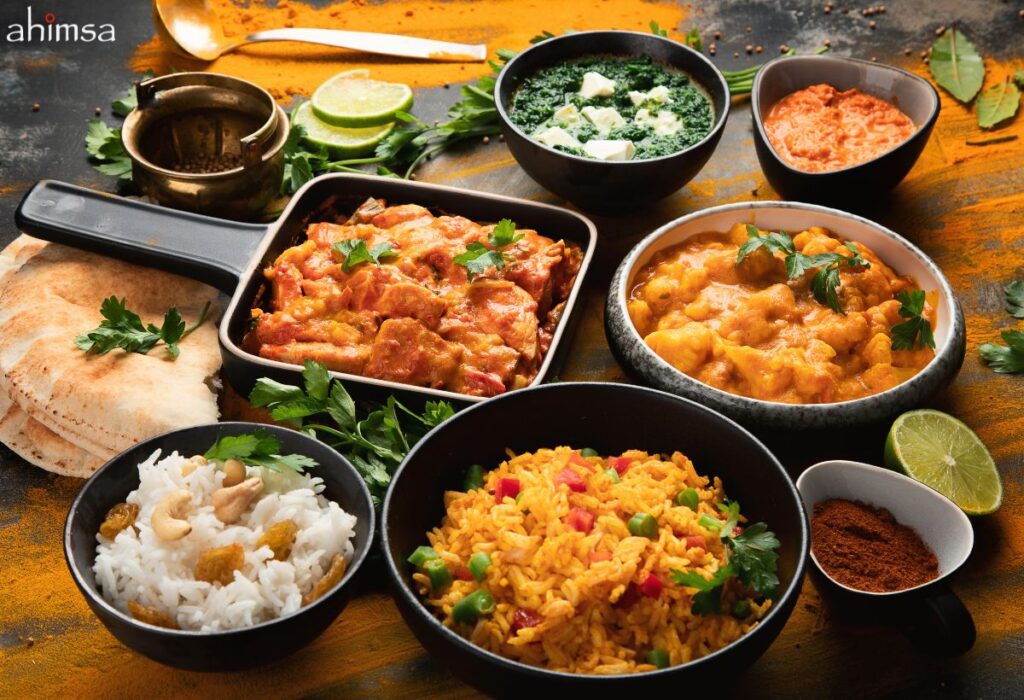India is home to 574 million vegetarians. No doubt, it ranks as the largest vegetarian-populated country in the world. The diversity of Indian vegetarian food is so vast that you could eat a different dish every day and would never run out of options. But some categories are slightly different from pure veg food. One of them is Jain food. It has some limitations, like you can’t add garlic, onions, or root vegetables to the food. In this post, we will explain the differences between Jain food and typical Indian vegetarian meals.
Origins & Philosophy
It is said that Jain food is one of the most disciplined vegetarian diets in the world, and it’s true. Its roots lie in the deep principles of non-violence (Ahimsa), but the food practices evolved with a sole purpose in mind: doing the least amount of harm, even to the smallest living things. That’s why it is prohibited to use root vegetables like onion, garlic, potato, and carrot, as their harvest kills underground organisms. Even fermented foods and honey are forbidden to eat.
On the other hand, Indian vegetarian food is way more diverse and changes after every 100 to 200 kilometers. It is influenced by Hindu, Buddhist, and cultural traditions. Indian vegetarianism excludes meat and eggs but includes onion, garlic, root vegetables, and processed food.
Cooking Practices & Utensils
In general, the kitchen should be the cleanest place in the house. And when you are cooking Jain food, cleanliness becomes more important. Utensils should be as clean as a mirror. Food is always prepared fresh, often just before mealtime. Leftovers are not allowed. The belief is simple: stale food breeds bacteria and reduces pranic energy (life force). Even water is filtered and stored carefully to avoid harming microscopic life. Separate utensils are used for Jain cooking to prevent food contamination.
One of the Jain cooking practices is called choviar, in which cooking or eating is avoided after sunset. Because fire and light lure tiny insects that could be unknowingly harmed. In contrast, regular Indian food in NYC has no such restrictions. Pressure cookers, microwaves, refrigeration, and fermented foods are all part of everyday prep. The goal is to make mouthwatering food that you can eat anytime. But hygiene is important in this, too.
Culinary Examples
If you have visited any Indian food restaurant, you may have been puzzled ordering from the menu, as there are endless options. Starting from the snacks to dine on, you will get everything. Paneer butter masala, aloo gobi, and masala dosa with coconut chutney are some of the famous dishes that are most ordered in Indian eateries. But when it comes to Jain food, the rules of the kitchen change. The meals are similar to Indian vegetarian food, but only the ingredients and cooking practices change in Jain food.
Take paneer curry, for example. In a typical Indian kitchen, it’s cooked with garlic, onions, and strong spices. The Jain version of paneer curry is equally tasty, but the only difference is that it is cooked without onion, garlic, or root vegetables. Even dosa, a South Indian staple, can be made according to Jain traditions. Normally, dosa is made with fermented batter and a potato filling (a root veggie no-go). In the Jain version, fermentation is skipped, and the filling is replaced with another vegetable or left plain, served with chutney made without garlic. Signature dishes in Jain restaurants in NYC are steamed dhokla or khichdi.
Common Misconceptions
When people hear “Jain food,” they often think of plain, tasteless, or restrictive foods. But that’s not true at all. Well, it’s a fact that Jain cuisine doesn’t have onion, garlic, or root vegetables, but it doesn’t mean that it will not have flavor. In fact, Jain cuisines are as delicious as vegetarian Indian food in NYC.
Myth #1: Jain food is bland.
Jain dishes are appetizing and aromatic. Several Indian restaurants serve Jain dishes rich in taste.
Myth #2: All Indian vegetarian food is Jain.
Not every Indian vegetarian food falls in the list of Jain food.
Myth #3: Jain food is only for Jains.
Nope! Jain food is consumed worldwide by health-conscious people, yogis, and even celebrities for its lightness, digestive benefits, and connection to mindful eating.
The Takeaway
In short, Jain food and Indian vegetarian food are similar to an extent, but they are different in some aspects. Jain food is based on a particular principle that discourages the use of root vegetables, onions, garlic, fermented foods, and many other things. Indian vegetarian food is more flexible and includes a variety of ingredients and local flavors. If you’re interested in trying Jain food, check out Ahimsa NYC. It is an authentic Indian vegetarian restaurant in New York that offers Jain, gluten-free, and vegan dishes that are both delicious and healthy. Visit now!



